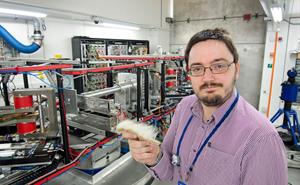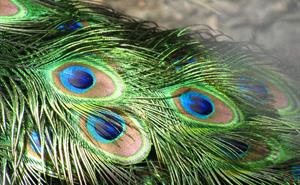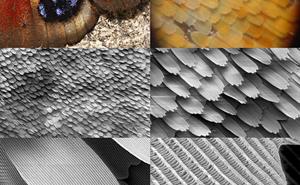Their goal is to find a way to artificially mimic nature's achievement and apply it to industry to make non-toxic, environmentally-friendly paints that never fade and could have a host of other benefits.
From iridescent beetles, luminescent sea creatures, rainbowed birdlife, and the infinite palette of plant life's floral decorations – the natural world is a resplendent cornucopia of vivid colourations. Although we humans have managed to artificially recreate many of these colours, we have barely managed to scratch the surface when it comes to understanding the complex mechanisms that nature uses to create its multi-chromatic splendours.
Most of us think of colour as being the result of pigmentation. Pigments are materials that absorb certain wavelengths of light and reflect others – it is the reflected wavelengths that our eyes detect as colour (a red pigment will reflect red wavelengths and absorb the rest). The vast majority of the colours we create are the result of pigments and mixtures of pigments.
But nature is not restricted to the light-absorbing powers of pigmentation. It can also turn the process on its head and use materials that luminesce and emit certain wavelengths of light to make up its colours. Then there is Nature's greatest achievement of colour-creating wizardry: the ability to create colour from structures that are themselves colourless – a process known, logically enough, as structural colouration.
Structural colour is achieved by taking advantage of the way that light waves interact with different structures. Some structures cause light to scatter, others cause it to diffract, and others cause light waves to interfere with each other. Although they work in different ways, each of these mechanisms mean that only certain wavelengths of light leave the surface of the object and reach the eye to be interpreted as colour. Sometimes these colours are fixed, but some can iridesce and change colour depending on the lighting conditions or the angle from which they are viewed.
In nature, structural colour arises through the interaction of light with complex nanostructures (structures measuring only a few billionths of a metre) found in the feathers of birds, the petals of flowers, the wings of butterflies, the shells of beetles, and even in the fur of mammals like polar bears. The English scientist, Robert Hooke, first described structural colour in 1665, but it is only recently that scientists have had the tools available to help them understand and recreate it.


Left: STFC scientist Dr Adam Washington with the sample of polar bear currently under examination at ISIS Neutron and Muon Source. (Credit: STFC)
Right: The Cyphochilus beetle has white scales that, despite being only a few thousands of a millimetre thick, are almost perfectly opaque. (Credit: Creative Commons)
A team of researchers from the University of Sheffield are using Larmor to study structural colour in polar bear fur.
You might not think of polar bears as being particularly colourful, in fact they are best known by their lack of colouration, but their thick white coats hide a secret: polar bears are actually black!
Or, to be precise, polar bear skin is black (black helps them to absorb as much heat as possible from the feeble polar sun) and their fur is colourless and see-through – it is the structural adaptations within the fur that gives a polar bear its gleaming white Artic coat.
The team at ISIS are investigating insect scales, bird feathers, and polar bear fur to see whether the structural properties that give the fur its colour can be transferred to industrial or commercial applications. In particular, they want to find out if it can be used to make white paint that uses structural colour instead of pigments. At the moment, the majority of white paints get their colour from the addition titanium oxide – a compound that is potentially damaging to soil and marine ecosystems if it leaches into the environment and that also has a significant carbon footprint due to the carbon dioxide emitted during industrial processing.
If white paint can be made that takes advantage of structural colour – using carbon instead of titanium, along with the environmental benefits, it may be possible to transfer the polar bear fur's heat-retentive properties and create a paint that insulates as well as decorates. Also, while pigment-based colours will degrade and fade over time, structural colours literally have the colours built in to them meaning that, in theory, the colour will last forever.
The ongoing study at ISIS builds on the team's previous work that looked at structural colour in the bright blue and white feathers of the Eurasian Jay (Garrulus glandarius) and in the exoskeleton of the Cyphochilus beetle, which produces a very opaque white colour from a very thin layer of scales. They aim to see what these creatures can teach us about creating pigmentless paints and, in the case of the Cyphochilus beetle, how to make paints that create vivid colours even in extremely thin layers – a trick the beetle has mastered.
Exploiting structural colouration could have all sorts of advantages beyond decorating your walls. Window coatings could be developed that allow visible light through but reflect infrared radiation (heat), thereby reducing the need for air conditioning in cars and buildings in hot climates. Cars could be painted in vivid colours that, as well as being environmentally friendly, would never fade in the sun, and clothes could be manufactured that would never fade in the wash.
Eliminating the need for potentially polluting chemical pigments could mean that the structures required to achieve colour might be constructed using carbon recycled from agricultural and food waste – doubling up on its 'green' credentials. Ironically, green is a colour that nature struggles to achieve through structural colour alone – requiring that 'structural blue' is mixed with a yellow pigment to absorb some of the blue colour.


Left: A peacock’s trademark iridescent tail feathers are created by structural coloration. (Credit: Creative Commons)
Right: Zooming into a butterfly’s wing at different magnifications reveals the microstructures that diffract high to create the intense colouration. (Credit: Creative Commons)
Article originally part of STFC's Fascination newsletter, posted here.
